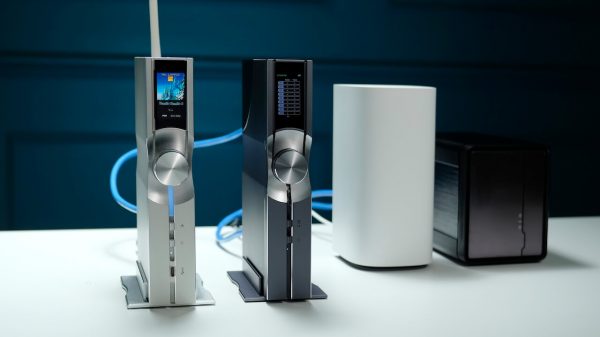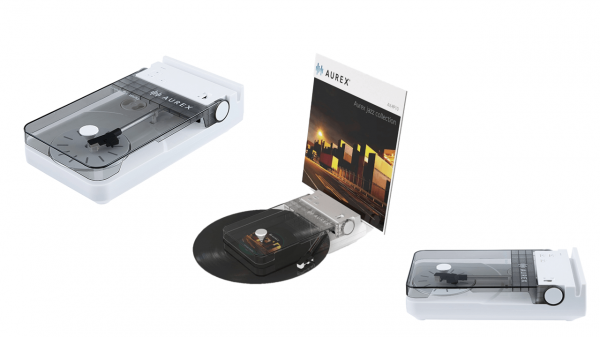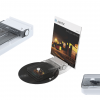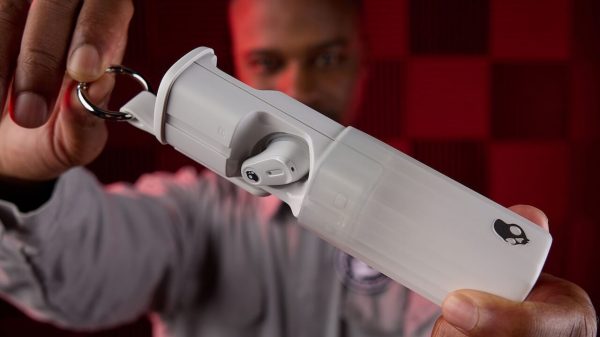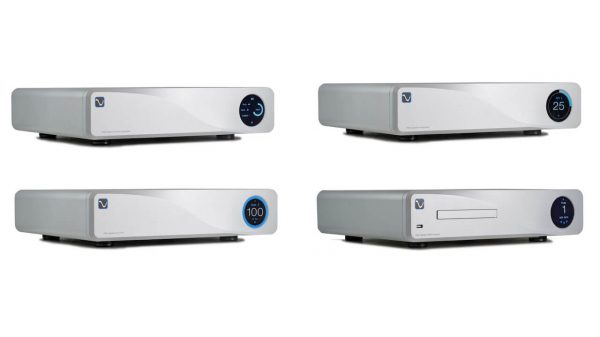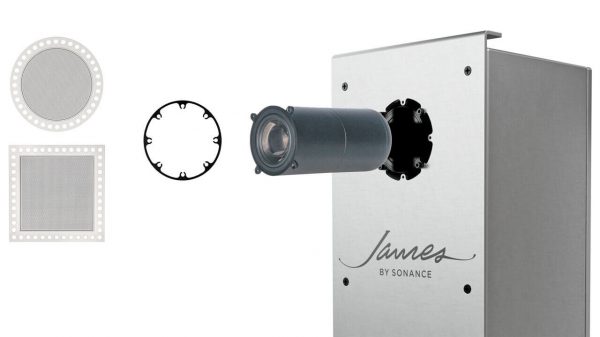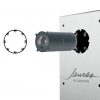Optoma is launching a new home entertainment projector line, the Photon Series, and the first entry, the Photon Go is being previewed at the 2025 Bristol HiFi Show that runs from Friday, Feb 21st through Sunday, Feb 23rd.
Overview
The Optoma Photon Go is designed for both home and on-the-go entertainment. Although we don’t know the exact details of what Optoma’s full Photon Series will offer, here is a look at its first entry that does not take up a lot of space.
To start, the Photon Go is a UST Projector. This means it is in the category of projectors that require minimal distance to project a large image on a screen or wall due to an innovative lens assembly. This type of projector is very practical for smaller spaces where there may not be enough room to place a standard throw projector that requires a longer distance to the screen to projector a large image.
Pro Tip: To dig deeper into how UST projectors work, refer to our article: WTF is UST Projector?

At the core of the Photon Go is its DLP imaging chip that is combined with an RGB triple laser light engine. As a result, pure red, green, and blue light sources eliminate the need for color wheels or filters. This means it can display a wider color gamut, higher color accuracy, and deeper contrast levels. Additionally, the RGB lasers maintain consistent brightness over time – up to 30,000 use hours.
In addition, an RGB laser light engine provides higher “perceived” brightness than a single laser or lamp projector with the same lumens rating.
With an ultra-portable design, built-in rechargeable battery (1.5 hours playtime), and integrated Google TV, the Photon Go can easily become a great video source for those who may not have a lot of space or may wish to take it with them on vacation.
It is also a great option for home movie nights, streaming the big game with friends indoors or outdoors, or creating an immersive gaming setup anywhere. It’s also practical for children’s rooms, transforming their bedroom walls into a giant screen.

The Photon Go has native 1080p Full HD resolution, however, according to Optoma, it will accept a 4K UHD resolution source image. In that case, compatible 4K UHD resolution signals will be scaled down to 1080p for image display.

The Photon Go’s ultra-short throw lens and auto image correction can project a 100-inch image from less than 25cm (9.84 inches) away from the wall.
With Wi-Fi connectivity, the Photon Go incorporates streaming via the Google TV OS. Google TV’s interface allows users to manage watchlists, and multiple profiles, and get personalized recommendations from all preferred streaming services, including Netflix, YouTube, Prime Video, Hulu, Disney+, and more.
In addition, both GoogleCast and Google Assistant are supported.

The Photon Go incorporates dual 10W built-in speakers with integrated Dolby Audio for better sound in a pinch. However, for best results, the Photon Go has a digital optical output for connecting the projector to a compatible external soundbar or audio system.
Pro Tip: The Photon Go can also be used as a Bluetooth Speaker
Comparison
Here is a specifications comparison between the Photon Go and the previously released GT3500HDR which are both reasonably priced UST projectors.

Model Photon Go GT3500HDR Projector Type UST (Ultra Short Throw) UST (Ultra Short Throw) Price £899 / €999.(US pricing forthcoming) £1,600.00, €1,590.00, $1,499.00 (US) Display Technology DLP DLP Light Source DuraCore MultiColor Laser DuraCore Laser Light Source Life 20,000 Hours 30,000 Hours (Eco Mode) Resolution 1080p Full HD 1080p Full HD Light Output (Brightness) 650 Lumens (WLO) 3,800 Lumens (WLO) Contrast Ratio Native 800:1, Dynamic 2,500,000:1 500,000: 1 Aspect Ratio Native – 16:9, Compatible with 16:1 and 4:3 Native – 16:9, Compatible with 16:1 and 4:3 3D Compatibility No Yes Keystone Correction Horizontal: +/- 10 degrees, Vertical +/- 5 degrees Horizontal: +/- 5 degrees, Vertical +/- 5 degrees Screen Size (Diagonal) 50 to 100 inches 80 to 130-inches Throw Ratio 0.18:1 0.25:1 Zoom Type Fixed 1.15x Input Connections 1 x HDMI 2.0, 1 c USB-C Power 2 x HDMI 2.0 Output Connections 1 x USB-A Power 1A, 1 x S/PDIF 1 x USB-A power 1.5A, 1 x Audio 3.5mm Control Connections 1 x RJ45 1 x RS232, 1 x RJ45, 1 x 3D sync HDR HDR10, HLG HDR10, HLG Speaker Number 2 1 Audio Power Output 2 x 10 watts 1 x 15 watts Dolby Audio Yes No Remote Control Yes Yes Networking WiFi 5 GHz Wired LAN Smart OS Google TV (includes Google Assistant and GoogleCast) None Bluetooth Yes No Gaming Support/Input Lag 27.10ms 8.6ms (1080p 120Hz)
17ms (1080p 60Hz)Fan Noise Level Min: 32dB, Max: 35dB 27dB Eco Mode Power Consumption Standby:0.5 watts – Operation Min: 50 watts, Operator Max: 60 Watts Standby:0.5 watts – Operation Min: 119 watts, Operator Max:173 Watts Battery Life Up to 1.5 hours Not Applicable Dimensions (WDH) 252 x 157 x 62mm (9.92 x 6.18 x 2.44 inches) 326.9 x 326.9 x 109 mm (12.87 x 12.87 x 4.29-inches) Net Weight 2.73kg (6 lbs) 3.9 kg (8.6 lbs) IP Rating IP2X IP6X Included Accessories Power Adapter
Power Cord
Remote Control with Batteries
User ManualAC power cord
Remote control
1x CR2025 Battery
User Manual
From Oliver Blundell, Product Manager for Home & Mainstream at Optoma: “We believe entertainment should be accessible to anyone, anytime, and the Optoma Photon Go embodies that vision. This projector redefines portability while offering premium performance,”

The Bottom Line
Optoma is making an interesting move in the UST space with the release of the Photon Go. On the one hand, is it very compact, making it very easy to move around where needed, and the rechargeable battery certainly adds to its versatility; although we’re not sure how only 90 minutes of playtime is going to work for those watching a movie with a longer duration if they don’t have a power source nearby.
However, in comparison to the not-too-much-more expensive GT3500HDR, it has a relatively low light output at only 650 lumens. This also means that even though it is HDR compatible, you won’t get the same HDR viewing experience as you would with the GT3500HDR or other projector with a higher lumen rating.
Also, for gaming, the Photon Go has a longer lag time than the GT3500HDR, making it more suitable for novice, casual gamers than serious dedicated gamers.
As a trade-off, the built-in streaming provided by Google OS means that you have access to lots of content right out of the box.
In my opinion, when shopping for a projector, I would rather have higher light output capability than smart features built-in, but for less than $1,000 (or in this case so far, less than 1,000 Euros or British pounds), it offers UST form factor and portability.
As stated at the top of the article, we don’t know what other offerings will become available for Optoma’s Photon Series (will they all be USTs or a mix of UST, Short Throw, and Standard Throw) and if the features, specs, and pricing will be consistent across models.
Price & Availability
The Optoma Photon Go will be available beginning in April 2025 at £899 / €999. US Pricing has not been announced but should be forthcoming.
For more information: optomaeurope.com
Related Reading



